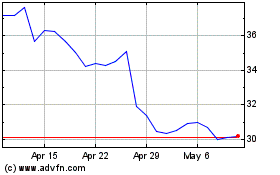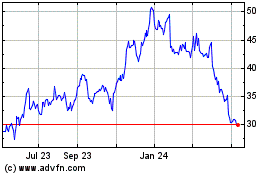By Georgia Wells and Yoree Koh
Champions of Silicon Valley's efforts to make the technology
industry more inclusive of women and minorities are facing an
unwelcome reality: not all employees have bought into the diversity
push.
The recent manifesto criticizing Google's initiatives wasn't the
first time Danielle Brown, Google's new head of diversity, had
encountered opposition.
Previously, when Ms. Brown had the same role at Intel Corp.,
employees anonymously posted approximately 40 negative comments on
an internal company website in response to positive articles about
Intel's diversity programs, according to a former Intel employee.
Ms. Brown left Intel in June to join Google.
Some of the comments questioned why Intel was devoting $300
million over a number of years to improve diversity, or suggested
managers would be forced to hire unqualified workers to satisfy
goals, according to the former employee. Other comments said the
initiative was just for good public relations.
"This work is hard," Ms. Brown said in an interview with The
Wall Street Journal in February about her work at Intel.
"Engineers...don't believe we have a problem until we see the data
behind it."
One reason for the skepticism is that three years and hundreds
of millions of dollars spent on diversity have produced meager
results.
The tech industry continues to be a mostly white or Asian male
workforce. Google, part of Alphabet Inc., said in June that 69% of
its staff is male, only 1 percentage point less than in 2014, the
first year it began reporting its diversity numbers. At Intel, 85%
of U.S. employees are either white or Asian, the company said in
December, also down just 1 percentage point from three years
ago.
Google parent Alphabet has over 75,000 employees and Intel has
more than 100,000, making it harder for those companies to move the
percentages.
The people with the most to lose may also resist change to how
the system works. "Diversity efforts can be a tough sell to some
employees -- primarily those from majority groups," said Joelle
Emerson, chief executive of Paradigm, a consultancy that advises
many Silicon Valley companies on diversity. "It's not uncommon for
people to worry about the implications these efforts will have for
them."
Intel's new chief diversity and inclusion officer, Barbara Whye,
said in a statement that Intel's diversity efforts make it a
stronger company. "We remain steadfast in our commitment to our
diversity and inclusion efforts," she said.
Through a Google spokesman, Ms. Brown declined to comment for
this article.
James Damore, the Google engineer who was fired Monday, said he
wrote his memo decrying Google's diversity efforts after attending
a diversity program that he disagreed with. It wasn't clear what
sort of program Mr. Damore meant. In recent months Google has
offered optional unconscious-bias training sessions for its
workers.
"I had some discussions with people there but there was a lot of
just shaming. 'No, you can't say that. That's sexist. You can't do
this,'" Mr. Damore said in an interview with conservative YouTube
personality Stefan Molyneux that appeared on Google's video
platform this week. "There's just so much hypocrisy in a lot of the
things they're saying, so I decided to create the document to
clarify my thoughts."
In his memo, Mr. Damore said that he doesn't think "diversity is
bad" but argued that Google's approach to fixing it is flawed
because of what he called the company's liberal bias. A spokesman
for Google declined to comment. Mr. Damore didn't respond to a
request for comment.
Proponents of diversity efforts point to academic research
showing that a workforce comprised of people of different race,
ethnicity, gender and sexual orientation leads to better
performance. A 2012 study conducted by professors at the University
of Maryland and Columbia Business School found companies in
Standard & Poor's Composite 1500 list with women in top
management were valued more highly.
But in a data-driven industry like tech, it can be harder to
convince employees of the value of hard-to-measure diversity
initiatives, executives say. "We don't have a numerical measure to
say that our bias was a 10 and now it's a six," Maxine Williams,
head of diversity at Facebook Inc., said in an interview last
week.
She says that Facebook has tried to make diversity top of mind
at "every micromoment." For instance, when a manager is writing a
performance review for a woman, a prompt pops up reminding them to
use the same language as they would for a male employee under
review.
Other companies measure progress in different ways. For
instance, the Clorox Company challenged its Asian, Black, Latino,
LGBT, millennials, and women resource groups to come up with ideas
for new consumer products, says Erby L. Foster Jr., Clorox's
director of inclusion and diversity until last month. Mr. Foster
left to start his own consulting business. Clorox's Asian resource
group developed and launched a new line of food storage containers,
for example.
At Intel, Ms. Brown focused on gathering data each time she
worked on an initiative, she said in the February interview.
When she wanted to address why employees of color left Intel
more frequently than white employees, for example, her team
surveyed more than 15,000 employees about barriers to retention and
promotion. One finding was that not all open positions included a
job posting. Under her watch, Intel met its goal of making 45% of
new hires women or people of color, and increased the percentage of
women in the company's workforce by more than 2 percentage
points.
Ms. Brown also worked on a service allowing employees to share
confidentially if they were having cultural problems on their team
or if they felt like they didn't have a plan to reach the next job
tier.
Intel executives had told hiring managers and recruiters that
the diversity programs wouldn't affect the qualifications of who
they chose to hire and promote, according to the former Intel
employee. Intel declined to comment.
But the feedback still had an impact: Intel decided to close the
comments section on diversity-related posts.
--John Simons and Jack Nicas contributed to this article.
(END) Dow Jones Newswires
August 10, 2017 13:02 ET (17:02 GMT)
Copyright (c) 2017 Dow Jones & Company, Inc.
Intel (NASDAQ:INTC)
Historical Stock Chart
From Apr 2024 to May 2024

Intel (NASDAQ:INTC)
Historical Stock Chart
From May 2023 to May 2024
